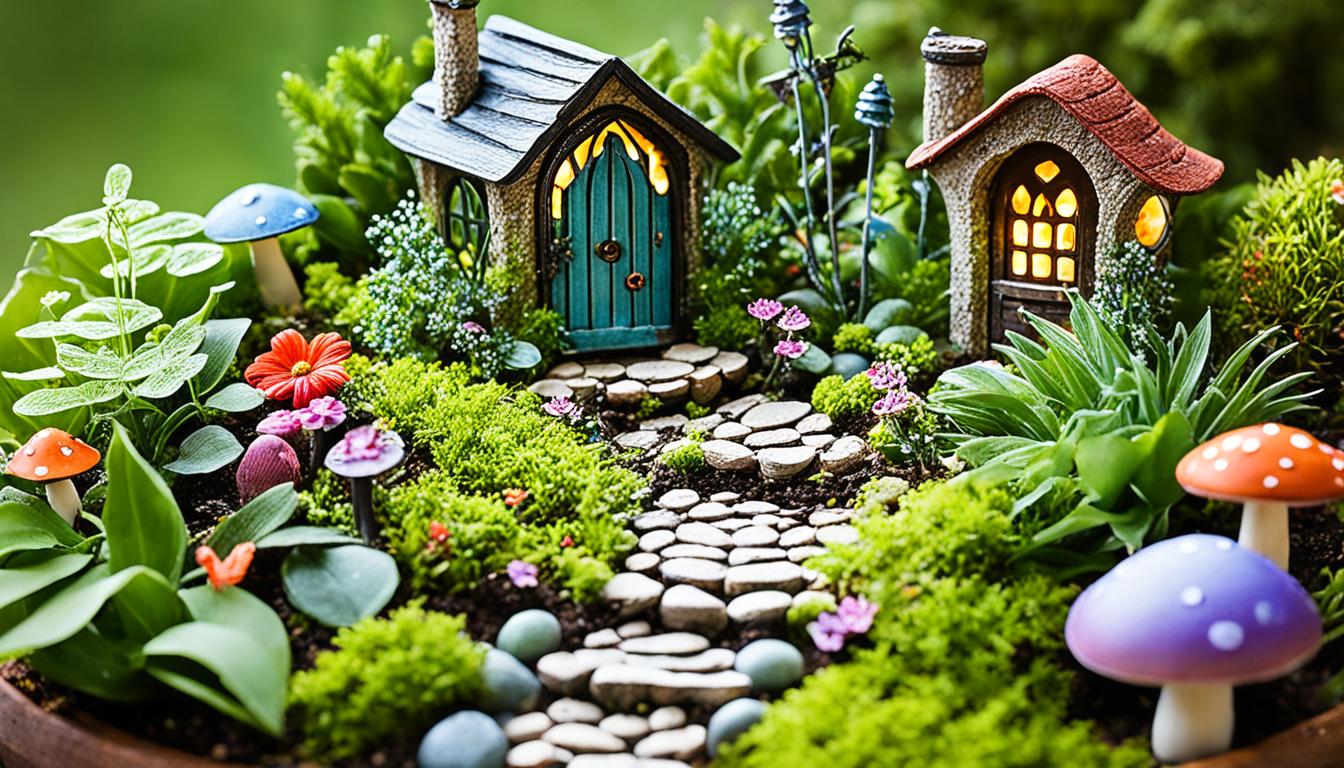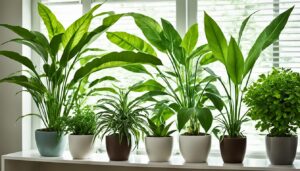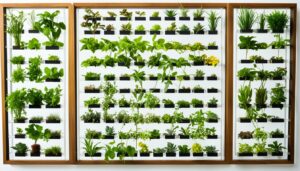Ever dreamed of making a tiny, magical world in your home or garden? A DIY fairy garden could be perfect for you. These gardens mix living plants with cute accessories to add magic to any spot.
Fairy gardens let you show off your creativity and connect with nature in a small way. They’re great for both experienced gardeners and beginners. Every step, from picking the right container to choosing plants, lets you make your dream come true.
Starting this whimsical garden project brings joy and wonder. You can choose from many themes, like woodland or beach. Let’s explore how to make your own fairy garden masterpiece.
Key Takeaways
- Fairy gardens combine miniature plants with tiny accessories
- They can be created in various containers for indoor or outdoor use
- DIY fairy gardens allow for creative expression and connection with nature
- Choosing the right plants and accessories is key to a successful fairy garden
- Fairy gardens can be themed to suit different styles and preferences
- Creating a fairy garden can be a fun and rewarding project for all ages
Introduction to Fairy Gardens
Fairy gardens add a magical touch to your home or garden. They mix living plants with tiny accessories. This creates enchanting scenes that spark imagination. Let’s dive into the world of fairy gardens and see why they’re so loved.
What is a fairy garden?
A fairy garden is a whimsical project that blends tiny plants with small decorations. It often includes fairy figures, small houses, and mini furniture. You can start with simple potted gardens or go for a big outdoor setup.
The magic and appeal of miniature gardens
Miniature gardens charm both kids and adults. They let you express your creativity and make fairy tales come alive. With their small size, you can add lots of details and create worlds in a little space.
“A fairy garden is a small window into a magical world, where imagination knows no bounds.”
Difference between fairy gardens and miniature gardens
Fairy gardens and miniature gardens are similar but have their own unique traits:
| Fairy Gardens | Miniature Gardens |
|---|---|
| Focus on whimsical elements | Aim for realistic, scaled-down landscapes |
| Include fairy figurines and magical accessories | Feature miniature plants and realistic decorations |
| Emphasize fantasy and imagination | Strive for accuracy and proportion |
| Often incorporate bright colors and glitter | Use natural colors and textures |
Whether you’re into fairy gardens or miniature gardens, both are great for creativity and self-expression. These projects let you add magic to any space, indoors or outdoors.
Essential Materials for Your DIY Fairy Garden
Starting a DIY fairy garden is exciting. You’ll need some key items to make it magical. Let’s look at what you’ll need for your project.
First, pick a container for your fairy garden. You can use a shallow pot, a wooden box, or something old like a vintage teacup. Make sure it has good drainage to keep your plants healthy.
Next, get the right soil mix. A potting soil that drains well is best for fairy garden plants. Add small pebbles or gravel for better drainage and to make paths look natural.
- Miniature plants
- Decorative accessories (fairy figurines, tiny houses, bridges)
- Small tools (tweezers, pruning shears, mini shovel)
- Natural elements (moss, bark, twigs)
- Sand or fine gravel for pathways
Choose slow-growing plants for your fairy garden. Succulents, small ferns, and miniature ivy are great choices.
Add whimsical touches with fairy garden accessories. Tiny furniture, houses, and fairy figures make your garden magical. You can find these at craft stores or make them yourself using natural materials.
“A fairy garden is a miniature world where imagination knows no bounds.”
With these supplies, you’re set to start your DIY fairy garden. Let your creativity shine and create a tiny world that brings joy and wonder.
Choosing the Perfect Container
Choosing the right container is key for your fairy garden. It sets the scene and affects how it looks and works.
Types of Containers Suitable for Fairy Gardens
Fairy garden containers vary in shape and size. You can use terracotta pots or wooden boxes. For something unique, try old teacups, wagon wheels, or broken pots. Wide, shallow containers give more space for your fairy world.
Indoor vs. Outdoor Fairy Gardens
For an indoor fairy garden, pick containers that match your decor. Make sure they have drainage to avoid water damage. For outdoor gardens, choose materials like ceramic or resin that can handle the weather.
Ensuring Proper Drainage
Good drainage is crucial for fairy gardens inside or outside. If your container doesn’t have holes, put pebbles at the bottom. This stops water from pooling and keeps plants healthy.
| Container Type | Indoor Fairy Garden | Outdoor Fairy Garden |
|---|---|---|
| Terracotta Pot | Good | Excellent |
| Glass Bowl | Excellent | Poor |
| Wooden Box | Good | Good |
| Resin Planter | Good | Excellent |
Your fairy garden container should show your style and be a good home for your plants and fairy friends.
Selecting Miniature Plants for Your Fairy Garden
Choosing the right plants is key to a magical fairy garden. Think about where and how your garden will be. Pick plants that are small or grow slowly for a charming look.
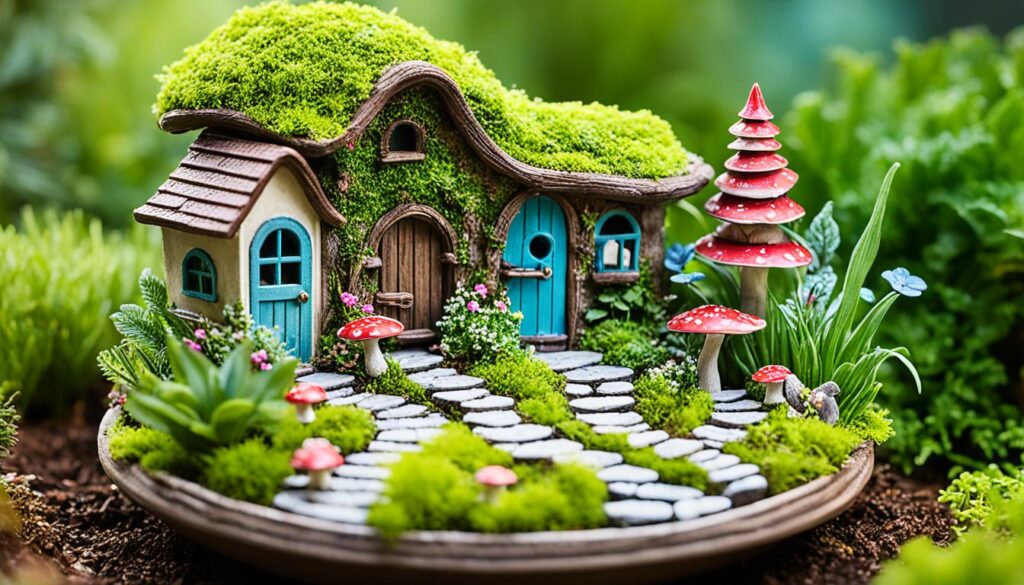
Succulents are great for dry places. They’re easy to care for and bring interesting textures to your garden. Some top picks include:
- Echeveria
- Sedum
- Haworthia
In damp areas, mosses and ferns are perfect. They give your garden a lush, forest vibe. Here are some top picks:
- Irish moss
- Baby tears
- Miniature ferns
Think about how much sun your garden gets. For sunny spots, choose plants like:
- Creeping thyme
- Miniature roses
- Dwarf conifers
Make sure all your plants need similar care. This makes upkeep simpler and keeps your garden magical all year.
| Plant Type | Climate | Sun Exposure | Water Needs |
|---|---|---|---|
| Succulents | Arid | Full to partial sun | Low |
| Mosses | Humid | Shade to partial sun | High |
| Miniature Roses | Temperate | Full sun | Moderate |
DIY Fairy Garden: Step-by-Step Guide
Creating a DIY fairy garden is a magical journey that brings miniature worlds to life. This guide will help you craft your own enchanting space. It’s perfect for fairies and imagination alike.
Preparing Your Container
Start by choosing the right container for your fairy garden. Make sure it has proper drainage to keep your plants healthy. Drill holes in the bottom if needed, and add a layer of small rocks for extra drainage.
Creating a Base Layer
Fill your container with a rich, well-draining potting mix. This base layer is crucial for your fairy garden ideas DIY to thrive. Add some sand or perlite to improve drainage if your soil is heavy.
Arranging Plants and Decorative Elements
Select miniature plants that fit your fairy garden theme. Place larger plants first, then add smaller ones around them. Incorporate tiny fairy houses, furniture, and figurines to create a whimsical scene.
Adding Pathways and Water Features
Create charming pathways using pebbles, gravel, or sand. For a magical touch, add a “pond” using a small mirror or blue glass beads. These elements bring your DIY fairy garden to life and spark creativity.
| Element | Purpose | Materials |
|---|---|---|
| Container | Base for fairy garden | Pot, box, or basket |
| Soil | Plant growth medium | Potting mix, sand |
| Plants | Living elements | Miniature plants, succulents |
| Decorations | Fairy-themed accents | Tiny houses, furniture |
| Pathways | Create garden layout | Pebbles, gravel, sand |
| Water Feature | Add magical element | Mirror, blue glass beads |
With these steps, you’ll create a charming DIY fairy garden that brings joy and wonder to any space. Let your imagination run wild and enjoy the process of building a fairy garden filled with tiny treasures and lush greenery.
Crafting Fairy Garden Accessories
Unleash your creativity with DIY fairy garden accessories! Crafting miniature elements adds a personal touch to your magical world. Let’s explore some enchanting ideas for fairy garden crafts that will transform your tiny landscape.
Polymer clay is great for making fairy garden accessories. Shape tiny vegetables, tools, or furniture pieces, then bake them to harden. Paint your creations for added realism and charm.
Nature has lots of materials for rustic miniature garden accessories. Collect acorns, twigs, and pebbles to craft unique elements. Use acorn caps as tiny bowls or create a twig ladder for your fairy friends.
Make your fairy garden come alive with miniature houses. Use popsicle sticks, bark, or polymer clay to craft them. Add moss roofs or tiny windows for a whimsical touch. Paint details like bricks or wood grain to enhance the magical atmosphere.
| Material | Fairy Garden Craft Ideas | Difficulty Level |
|---|---|---|
| Polymer Clay | Miniature vegetables, fairy tools, tiny furniture | Medium |
| Natural Materials | Acorn bowls, twig ladders, pebble pathways | Easy |
| Popsicle Sticks | Fairy houses, miniature fences, tiny bridges | Medium |
The key to creating captivating DIY fairy garden accessories is attention to detail. Experiment with different materials and techniques to craft a truly magical miniature world.
Incorporating Themes in Your Fairy Garden
Fairy garden themes can turn your miniature world into a magical place. By picking a theme, you make a space that tells a story. Let’s look at some popular themes for your fairy garden.
Woodland Fairy Garden Ideas
A woodland fairy garden feels like a forest hideaway. Use moss and tiny ferns for a lush floor. Add miniature mushrooms and figurines of animals like deer or owls to make it come alive.
Beach-Themed Fairy Gardens
Make a beach fairy garden with sand as the base. Add seashells, driftwood, and pebbles for a beach feel. Include miniature beach items like chairs and umbrellas. Use plants like succulents that do well in sand.
Seasonal Fairy Garden Designs
Change your fairy garden with the seasons. In spring, use tiny flowers and soft colors. Summer can have bright flowers and a picnic area. For fall, add autumn leaves and small pumpkins. Winter can have evergreens and snow effects.
| Theme | Key Elements | Recommended Plants |
|---|---|---|
| Woodland | Moss, mushrooms, forest creatures | Ferns, moss, miniature trees |
| Beach | Sand, shells, beach accessories | Succulents, air plants |
| Seasonal | Holiday decorations, seasonal colors | Varies by season (e.g., pansies for spring) |
For a great themed fairy garden, pay attention to details. Pick accessories and plants that fit your theme. This will make your miniature world magical and cohesive.
Maintaining Your Fairy Garden
Keeping your fairy garden in top shape is key. Regular care keeps tiny plants healthy and your garden magical.
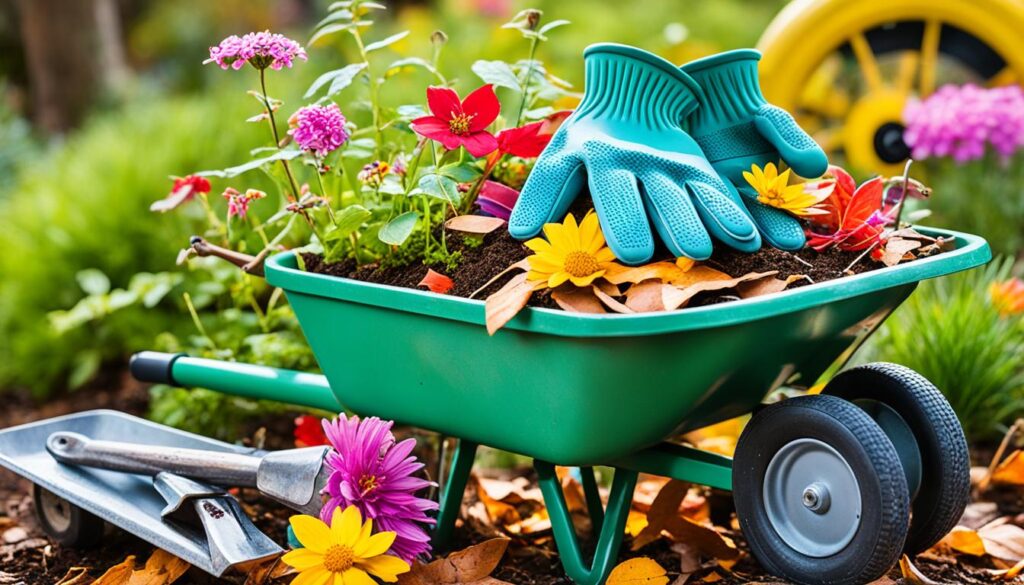
Watering is key in caring for your garden. Check the soil daily and water when it’s dry on top. Be careful not to harm the plants or decorations. Use a spray bottle for watering in small spaces.
Pruning is important for your fairy garden. Cut back overgrown plants to keep the garden looking right. Remove dead leaves and flowers to keep things clean and healthy.
- Inspect plants for pests or diseases regularly
- Rotate your garden occasionally for even sunlight exposure
- Replenish soil nutrients with a diluted fertilizer every few months
For outdoor fairy gardens, protect them from bad weather. Move gardens indoors during extreme weather. Indoor gardens need misting now and then to keep humidity up.
Check and fix fairy garden items often. Make sure paths are clear and mini structures are secure. Replace any broken items to keep the garden looking great.
With the right care, your fairy garden will always be a magical place. It will be a tiny world full of wonder and delight.
Fairy Garden Ideas for Different Spaces
Fairy gardens add magic to any space, big or small. Whether you’re looking for ideas for inside or outside, there’s a perfect spot for you. Let’s dive into some creative ways to add these whimsical worlds to your home and yard.
For indoor spaces, windowsills and shelves are great for fairy gardens. Create a charming scene with low-light plants like ferns and mosses. Add tiny furniture, miniature houses, and fairy figures to make it come alive.
Outdoor fairy gardens can blend into your yard or stand out in containers. Turn a yard corner into a magical spot with these tips:
- Use tree stumps as fairy houses
- Create a fairy village in a large planter
- Design a fairy garden pathway with pebbles and miniature plants
Fairy gardens can even go vertical. They’re great for small spots or balconies. Try hanging baskets or old ladders for multi-level fairy worlds.
| Space | Fairy Garden Idea | Key Elements |
|---|---|---|
| Indoor | Terrarium Fairy Garden | Glass container, succulents, miniature figurines |
| Outdoor | Fairy Garden Pond | Small water feature, aquatic plants, fairy bridge |
| Vertical | Fairy Garden Wall | Wall-mounted planters, trailing plants, tiny ladders |
The secret to a great fairy garden is creativity and detail. Let your imagination soar as you craft these magical spaces in your home and garden.
Engaging Children in Fairy Garden Creation
Fairy gardens are a magical way to spark creativity in kids and teach gardening skills. They are an enchanting activity that mixes imagination with hands-on learning.
Educational Benefits of Fairy Gardening for Kids
Children’s fairy gardens offer many learning chances. Kids learn about taking care of plants, making ecosystems, and improving their fine motor skills. They also get to use their imagination, telling stories about the tiny creatures in their gardens.
Kid-Friendly Fairy Garden Projects
Here are some fun projects for young gardeners:
- Paint small pots for fairy houses
- Create accessories from air-dry clay
- Arrange pre-made elements in unique ways
- Use natural materials like twigs and pebbles to build fairy furniture
Fairy Garden Birthday Party Ideas
Have a magical fairy garden birthday party where kids make their own mini gardens. Set up stations with different supplies and let their imaginations soar. These personalized gardens are great take-home gifts, keeping the magic alive.
Fairy gardens are a great way to teach kids about nature and boost their creativity. They make for memorable events, whether it’s a birthday or a weekend project. Fairy gardening captures the hearts and minds of young people.
Conclusion
Creating a DIY fairy garden is a magical journey that blends creativity with nature. It’s a unique way to express your imagination and add enchantment to any space. By choosing the right miniature plants, you can make a tiny world that charms everyone.
Fairy gardening is versatile. You can set up cozy indoor gardens or charming outdoor ones. These miniature gardens can grow in many places. You can make your fairy garden match different themes, seasons, or your interests, making it special.
Starting your fairy garden journey is as fun as the end result. You can make it with family, teach kids about plants, or just enjoy a hobby. Fairy gardening is a way to escape into a world of wonder. So, get your tools ready, let your imagination run wild, and watch your miniature oasis come alive!
FAQ
What is a fairy garden?
A fairy garden is a magical, small landscape filled with plants and tiny accessories. It’s a mix of gardening and imagination. It lets you create whimsical scenes.
What’s the difference between fairy gardens and miniature gardens?
Fairy gardens and miniature gardens are both small landscapes. But fairy gardens add fairy-themed items for a whimsical touch. Miniature gardens focus on realistic, smaller versions without the magical elements.
What materials do I need to create a fairy garden?
You’ll need a container with good drainage, the right soil, small plants, pebbles, and sand. Don’t forget miniature accessories. Tools like a small shovel and tweezers are also useful. Optional items include moss and UV resin for making your own accessories.
What are some good container options for fairy gardens?
You can use traditional pots or get creative with teacups, broken pots, or wooden boxes. Outdoor containers should be weather-resistant and have good drainage. Indoor containers should match your decor.
What plants are suitable for fairy gardens?
Choose small or slow-growing plants like succulents and mosses. Ferns, creeping thyme, and miniature roses work well too. Make sure all plants fit the garden’s location and care needs.
How can I create custom fairy garden accessories?
Use polymer clay to make tiny furniture, tools, or veggies. Bake them to harden. Add natural touches like twigs and acorns. Build houses with popsicle sticks or bark and decorate with paint and moss.
What are some theme ideas for fairy gardens?
Themes can be woodland with moss and mushrooms, beach with sand and shells, or seasonal designs with holiday decorations. Choose plants that bloom in different seasons.
How do I maintain a fairy garden?
Water plants as needed, prune to keep them small, and remove dead leaves. For outdoor gardens, protect them from extreme weather. Bring them inside during harsh seasons.
Can I involve children in fairy gardening?
Yes! Fairy gardening is great for kids. They can paint pots, make clay accessories, or arrange elements. You can even have fairy garden parties where kids make their own gardens.
Source Links
- https://lifeinmini.com/make-fairy-garden/ – How to Make a Fairy Garden
- https://www.notjustahousewife.net/diy-fairy-garden-ideas/ – DIY Fairy Garden Ideas – Stacy Risenmay
- https://minigardenguru.com/the-fairys-garden/ – How to Create A Delightful Fairy Garden For Everyone


